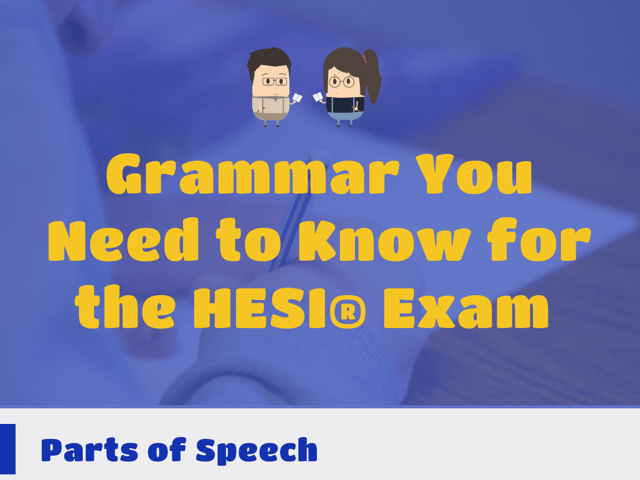
Grammar You Need to Know for the HESI® Exam
The grammar portion of the HESI® exam can be daunting, but knowing the basics of English grammar will go a long way in preparing you for the exam.
Parts of Speech
Parts of speech include verbs, nouns, pronouns, adverbs, and adjectives. A simple explanation of each is typically enough to identify each of the parts of speech. A verb is an action word. A noun is a person, a place, or a thing. A pronoun is a word used to replace a noun, such as she, instead of Karen. Adjectives are used to describe nouns, and adverbs are used to describe adjectives, verbs, or another adverb. Taking a few minutes each day to identify each of these word types in a series of sentences will help you find confidence in identifying parts of speech.
Punctuation and Capitalization
Punctuation and capitalization can be trickier; the English language has a lot of rules regarding punctuation, and some punctuation marks can seem to be interchangeable. Here are the basics of punctuation:
“End marks” mark the end of a sentence or complete thought:
-
a period (.) for a statement
-
an exclamation point (!) to express intense emotion
-
a question mark (?) to denote a question
Other punctuation marks signal different things, such as a pause:
-
A comma (,) connects two thoughts using a conjunction (such as and, or, and but, where the comma comes before the conjunction).
-
A colon (:) tells the reader something else related to the sentence is coming, such as a list or an explanation.
-
A semicolon (;) joins two independent clauses that are similar or related, or to separate longer items in a list.
-
Quotation marks (“ ”) indicate what a person actually said.
-
An apostrophe is used to indicate missing letters in a contraction (didn’t) and to signal possession (Sue’s purse).
Word Usage
The HESI® exam will also examine your knowledge of English words that appear similar to one another. These include their/they’re/there, you’re/your, and its/it’s. Similar-seeming words may also include definitely/defiantly, accept/except, affect/effect, and advice/advise. You must also be able to correctly use comparative suffixes (-er versus -est) and know the difference between less and fewer. –Er is used to indicate a comparison of two, and –est is used to indicate a comparison of three or more. Less is used for nouns that cannot be counted (“less sand,” for instance), while fewer is to be used for nouns that can be counted (such as “fewer cookies”).
Sentence Structure
Finally, be sure to study sentence structure for the HESI® exam. Sentence structure questions may be the trickiest on the exam, as they do not merely ask for the correct answer, but instead ask for the best answer. This means that multiple answers could be grammatically correct. When searching for the best answer, choose the option that uses punctuation to make the sentence’s meaning as clear as possible. Although “Cindy and Greg went to the pool; it was hot” is correct, it would be more concise to say, “It was hot, so Cindy and Greg went to the pool.”
Practice, Practice, Practice!
Grammar can seem overwhelming, but practicing for 10–30 minutes each day can help you grow more comfortable identifying different aspects of grammar and succeed on your HESI® exam. You can get started with our free study guides, practice questions, and flashcards for the HESI Grammar section.

Keep Reading

Health Education Systems Incorporated Exam Blog
HESI Anatomy and Physiology Review: A Comprehensive Guide
As you prepare for the Health Education Systems, Inc (HESI) Admission A…

Health Education Systems Incorporated Exam Blog
How to Pass the HESI Exam: A Comprehensive Guide to Acing Your Nursing Entrance Exam
If you’re considering becoming a nurse, the HESI exam can be a crucial …

Health Education Systems Incorporated Exam Blog
The Complete Guide to HESI Exam Scores
Are you ready to become a nurse? Many nursing schools require entrance …